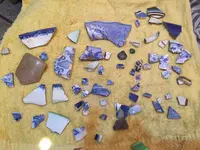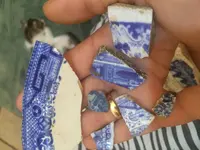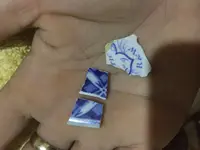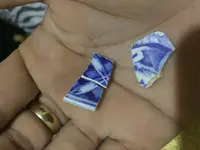You are using an out of date browser. It may not display this or other websites correctly.
You should upgrade or use an alternative browser.
You should upgrade or use an alternative browser.
Ceramics ?
- Thread starter Asherr
- Start date
Robot
Bronze Member
Welcome to the Show...Asherr
My opinion is that they are pieces of Delftware mid 18th Century made by the Dutch.
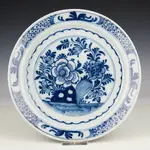
If these pieces came from St. Lucia, they could have been owned by the French or British which each ruled this small island 7 times up until 1814 when finally it became British and received full independence in 1979.
This particular pottery was highly sought after throughout Europe.
Keep searching this area as where pottery is located... so goes Treasure!
My opinion is that they are pieces of Delftware mid 18th Century made by the Dutch.

If these pieces came from St. Lucia, they could have been owned by the French or British which each ruled this small island 7 times up until 1814 when finally it became British and received full independence in 1979.
This particular pottery was highly sought after throughout Europe.
Keep searching this area as where pottery is located... so goes Treasure!
against the wind
Platinum Member
- Joined
- Jul 27, 2015
- Messages
- 24,797
- Reaction score
- 24,982
- Golden Thread
- 0
- Location
- Port Allegheny, Pennsylvania
- 🏆 Honorable Mentions:
- 1
- Detector(s) used
- E-trac, Excalibur, XP Deus, & CTX 3030.
- Primary Interest:
- All Treasure Hunting
My opinion is that they are pieces of Delftware mid 18th Century made by the Dutch.
View attachment 1753169
If these pieces came from St. Lucia, they could have been owned by the French or British which each ruled this small island 7 times up until 1814 when finally it became British and received full independence in 1979.
This particular pottery was highly sought after throughout Europe.
Keep searching this area as where pottery is located... so goes Treasure!
Great information,, thank you
A lot of what you have is mid 19th century Staffordshire (English) transfer ware. They "transferred" the pattern onto the pottery before putting it in the kiln.
Now, the blue and green "feather edge" is around 1780-1820 or so. We occasionally find it on late 18th century sites, and sites going into the 19th century.
The pieces on the right are called "mocha ware" and it was popular ca 1820-50's. The one tannish piece on the left is a stoneware. Stoneware on that small a piece is very difficult to date, but it probably dates to the same period.
Delft was much more fragile and you would see a lot more "flaking" of the coating with all the design coming off the coin if that was Delft. Delft used a tin glaze which was very fragile.
The only piece I see which I would say is absolutely Delft is to the right of the piece of stoneware (tan piece).
Now, the blue and green "feather edge" is around 1780-1820 or so. We occasionally find it on late 18th century sites, and sites going into the 19th century.
The pieces on the right are called "mocha ware" and it was popular ca 1820-50's. The one tannish piece on the left is a stoneware. Stoneware on that small a piece is very difficult to date, but it probably dates to the same period.
Delft was much more fragile and you would see a lot more "flaking" of the coating with all the design coming off the coin if that was Delft. Delft used a tin glaze which was very fragile.
The only piece I see which I would say is absolutely Delft is to the right of the piece of stoneware (tan piece).
Last edited:
CRUSADER
Emerald Member
Agreed, mostly 19th C blue & White.A lot of what you have is mid 19th century Staffordshire (English) transfer ware. They "transferred" the pattern onto the pottery before putting it in the kiln.
Now, the blue and green "feather edge" is around 1780-1820 or so. We occasionally find it on late 18th century sites, and sites going into the 19th century.
The pieces on the right are called "mocha ware" and it was popular ca 1820-50's. The one tannish piece on the left is a stoneware. Stoneware on that small a piece is very difficult to date, but it probably dates to the same period.
Delft was much more fragile and you would see a lot more "flaking" of the coating with all the design coming off the coin if that was Delft. Delft used a tin glaze which was very fragile.
The only piece I see which I would say is absolutely Delft is to the right of the piece of stoneware (tan piece).
Asherr
Greenie
- #9
Thread Owner
Many thanks everyone. A few of the pieces I found easily at the surface and then the others were exposed slowly every time some rain fell and washed down the path unearthing more bits. The ruins around the area go back to the 1700s at least. My colleagues and people around me would ask what am I doing why am I wasting my time... but too me this is a part of our past and so interesting to me. Time to go back and see what else I find!
A2coins
Ruby Member
Thanks for sharing that I love stuff like that just the History of it. I would love to find that even if just pieces Well done
Similar threads
- Replies
- 60
- Views
- 2K
- Suggestion
- Replies
- 17
- Views
- 806
Users who are viewing this thread
Total: 1 (members: 0, guests: 1)



